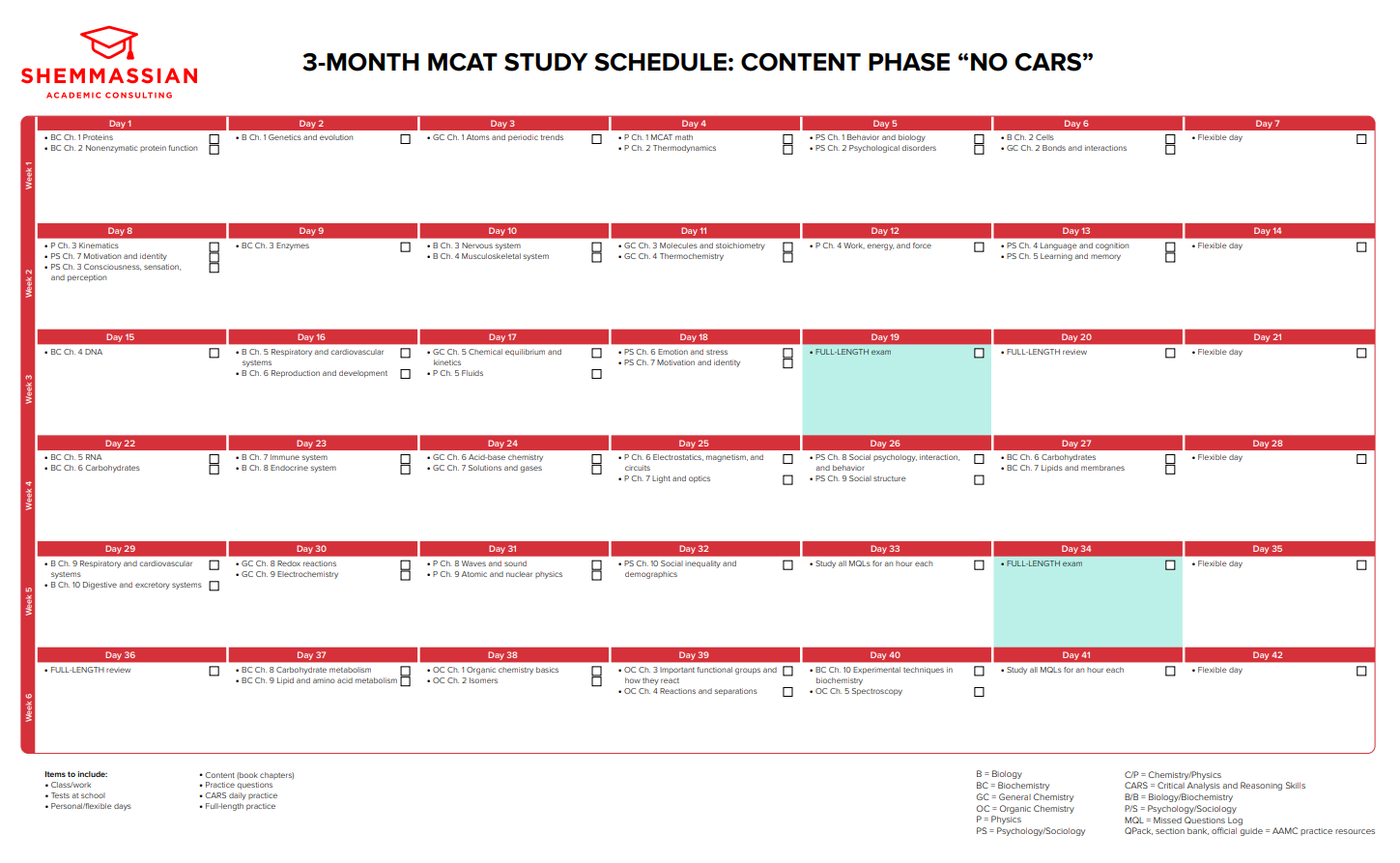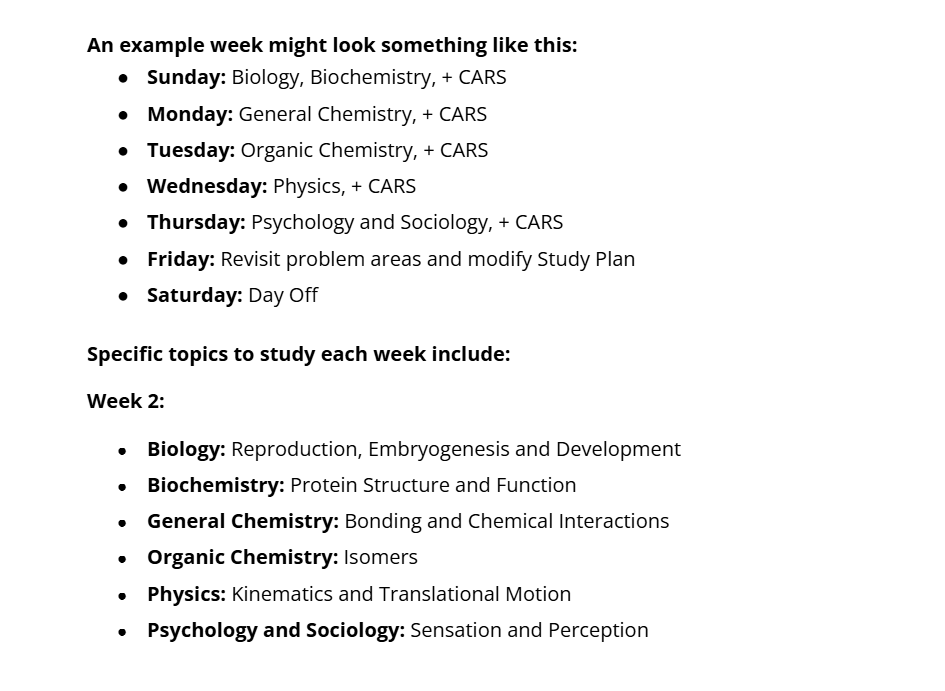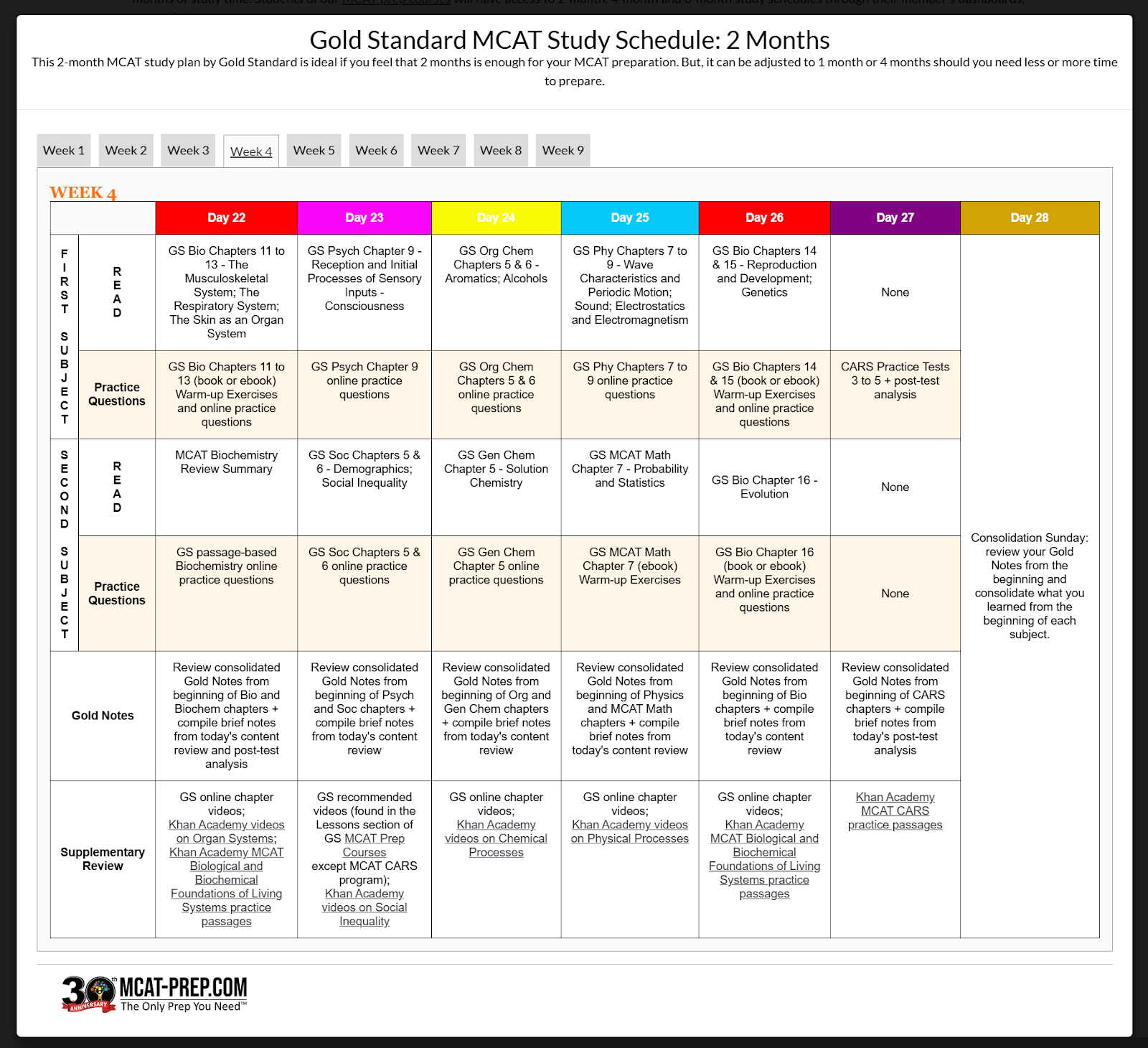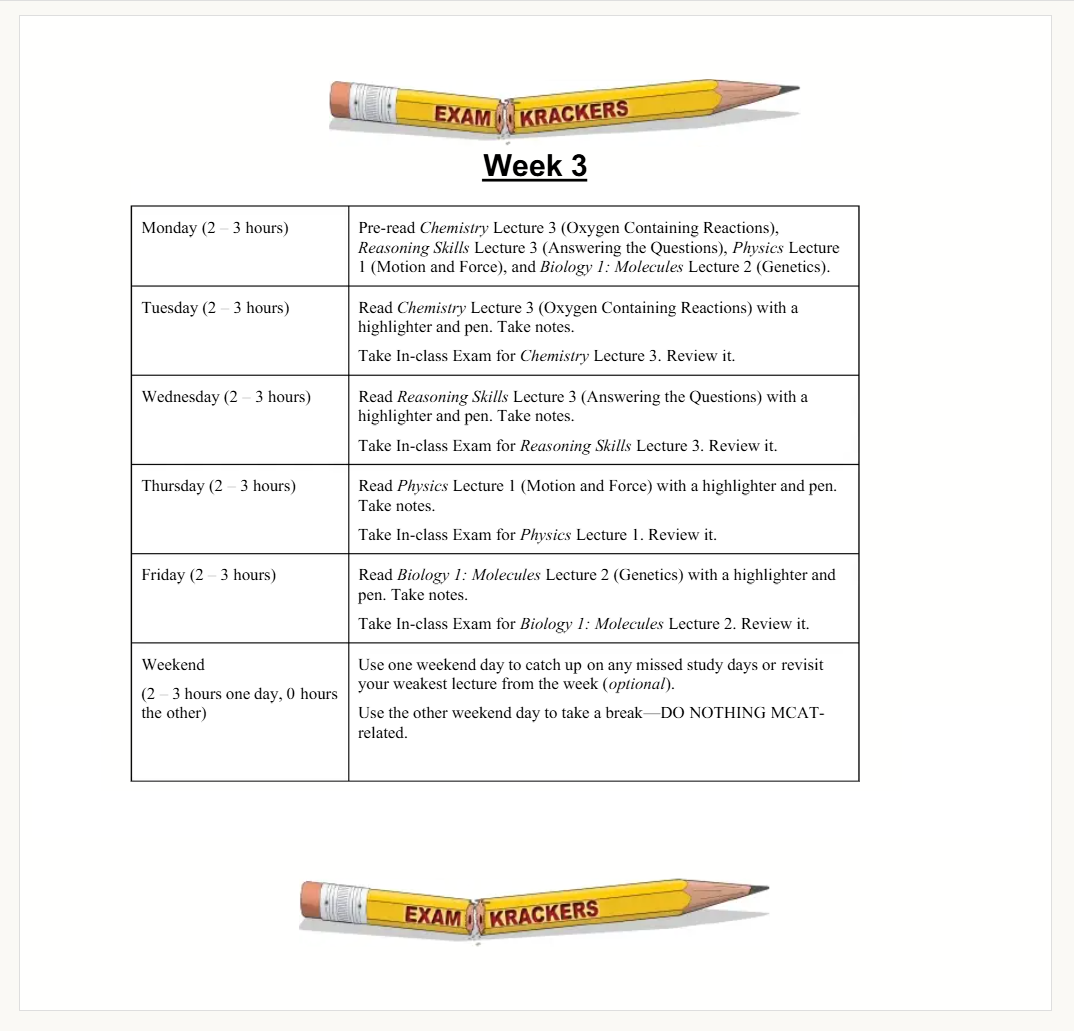Best MCAT Study Plan Templates (Free)
By Dr. Sarah Johnson • Updated 10/6/2025
Studying for the MCAT can feel like an endless mountain of content with no clear path.
Without a solid plan, it’s easy to get lost or feel burned out while juggling content review, practice tests, and a ticking clock.
Luckily, the best MCAT study plan templates are here to save the day, helping you organize your prep, stay motivated, and conquer the exam with confidence and ease.
If you’re looking for interactive tools to build your own custom study plan, check out our guide to the best MCAT study plan builders.
Better yet, if you’re looking for something even better than a static schedule, check out MCATStudyPlanner.com - a fully customizable tool that adapts to your timeline, strengths, and materials.
| Shemmassian Consulting Templates | Kaplan 3- Month Schedule | Gold Standard 2‑ / 3‑Month Schedules | Examkrackers 9th Ed. Home Study Schedule | |
|---|---|---|---|---|
| Duration / Timeline Options | 1, 2, 3, 4, Or 6 Months Very Flexible | 3 Months Fixed | 2 Or 3 Months Adaptable | 10 Weeks |
| Key Features | • Highly structured • Emphasizes strategy & error analysis | • Heavy content focus • Intense and fast-paced | • Intensive & condensed • Encourages active learning via “Gold Notes” | • Fast-paced & highly structured • Mid-point “soft week” for rest or catch-up |
| Content → Practice Shift | Gradual Transition (Starts heavy content, shifts toward practice) | Phases Content Review, Then Transitions Into Practice | Early Push Into Practice (Since time is limited) | Mix Of Content With Daily Passages (Practice ramps up mid/late phase) |
| Daily / Weekly Intensity | Moderate To High (Depends on chosen timeline) | Moderate | Very High (Compact schedule demands maximal daily effort) | Moderate To High (But efficient / high‑yield approach) |
| Buffer Days / Flexibility | Built-In Buffer Days For Catch-Up | Built-In Days Off | Minimal Buffer Little room for delays | Some Flexibility |
| Best Suited For | Students who want a strategic, high-efficiency, scalable plan. | Students looking for a disciplined, content-heavy prep routine. | Students with a strong baseline or retakers who need focused, fast review. | Students with limited time who want a concise, no-fluff schedule. |
Best MCAT Study Plan Templates In [year]
1. Shemmassian Consulting MCAT Study Plan Templates
Shemmassian Consulting’s MCAT study schedule templates are carefully designed, proven plans aimed at helping students achieve top MCAT scores of 520 and above.
These templates cater to various preparation timelines, ranging from 1 month to 6 months, and provide structured, actionable guidance to balance content review, strategic practice, and full-length exams.

Shemmassian Consulting’s study plan templates come as a suite of customizable PDFs broken into different phases.
Each schedule follows a two-phase structure: a content-heavy phase and a practice-heavy phase. Early in prep, you will cover ~70% content / 30% practice; then later on, more practice is incorporated, whereby you have ~70% practice / 30% content.
Because Shemmassian Consulting offers multiple timeline versions, here’s a rough sketch of what each plan entails:
-
1‑Month Schedule: Extremely intensive (roughly 7–8 hours of studying per day). Some content may be sacrificed in favor of more practice.
-
2‑Month Schedule: Roughly 5-6 hours of studying per day. You have slightly more breathing room to do content + practice phases.
-
3‑Month Schedule: Often cited as a “standard” balance, splitting study time into a content-review phase and a dedicated practice phase. About 3 hours of studying per day, depending on your other commitments.
-
4‑Month Schedule: More relaxed pacing, allowing for deeper review and more built-in buffer days. More breathing room for catching up.
-
6‑Month Schedule: Stretches content + strategy phases, allowing gradual buildup and more flexibility.
Pros
-
Professionally developed by top MCAT prep tutors.
-
Well‑balanced between content and practice, with thoughtful transitions.
-
Adaptable plans with flex days included so students can survive setbacks.
-
Integrated tools for accountability and error tracking (Missed Question Log, etc.).
Cons
-
Static PDFs (not interactive).
-
Shorter templates (1‑ or 2‑month) are very intense; if you miss even a few days, it’s hard to catch up.
2. Kaplan 3-Month MCAT Study Plan Template
The Kaplan 3-Month MCAT study schedule is a comprehensive, paced plan designed to prepare students effectively over 12 weeks.

The plan begins with a diagnostic exam to establish baseline knowledge and focuses on gradually reviewing all MCAT content areas.
Key features include:
-
Provides a clear roadmap rotating through all subject areas (Biology, Biochem, General/Organic Chem, Physics, Psych/Soc) to ensure balanced coverage.
-
The rotation framework allows you to adjust daily topics depending on how much time you have or how your mastery of certain topics evolves.
-
Daily CARS practice built in.
-
Phases content review, then transitions into practice + full-length tests.
-
Weekly or biweekly full‑length exams toward the later stages.
-
The “final week” focus on review / logistics / rest is a smart touch. Many students fail to build in downtime or mock testing logistics.
Kaplan’s 3-month study schedule typically involves studying 3-5 hours per day, six days a week, with one day off to recharge.
Pros
-
Well structured and organized, with a detailed weekly breakdown of topics.
-
Balanced rotation across all MCAT subjects, without neglecting any section.
-
Incorporates multiple full-length exams with review days to analyze performance.
-
Encourages using official AAMC resources (FL exams, Section Bank, Question Packs).
Cons
-
Frontloaded content review can delay exposure to critical practice-based learning (e.g., passages, timing).
-
May not include enough time for revisiting older topics.
3. Gold Standard 2‑ / 3‑Month MCAT Study Plan Templates
Gold Standard Test Prep offers flexible templates for 2‑month and 3‑month MCAT study plans, with downloadable PDF versions.
These well-structured plans are designed to help students efficiently prepare for the MCAT within a condensed timeline.

These schedules divide study time into balanced segments focusing on content review, practice questions, and full-length MCAT practice exams.
Key features include:
-
The schedule is segmented into thirds: roughly 1/3 of the time dedicated to content review, 1/3 to practicing questions, and the last 1/3 to full-length practice tests under timed conditions.
-
Practice questions (from AAMC sample/guide) are embedded early, alongside reading assignments.
-
Content review uses both the Official AAMC MCAT Exam Guide chapters and Gold Standard’s own book chapters (for instance, GS Physics, GS Biology).
-
Supplementary resources integrated include Khan Academy videos, online practice questions, and quizzes aligned with the Official AAMC MCAT Guide.
-
Students create “Gold Notes,” brief, active-study notes from their content review and question practice. These notes are reviewed periodically to aid long-term retention.
Better yet, Gold Standard’s study plan templates are adjustable. The plans can be extended or shortened to fit 1, 4, or 6 months based on students’ needs and prep time.
Pros
-
Prioritizes high‑yield content + practice from early on.
-
The flexible, customizable plans can be extended or shortened as per your needs.
-
Embedding AAMC sample questions early ensures alignment with what the real test demands.
-
The ‘Gold Notes’ concept reinforces good study habits for active learning and spaced repetition.
Cons
-
Very intense workload, whereby even with 3 months, the schedule is dense.
-
The plan is built for Gold Standard’s own materials + AAMC guides. If someone uses alternate books or merges question banks, mapping the plan might get tricky.
4. Examkrackers Home Study Schedule (9th Edition)
The Examkrackers 9th Edition Home Study Schedule is a detailed, structured 10-week plan designed to be used with the Examkrackers Complete Study Package and related materials.

It recommends starting exactly ten weeks before the MCAT and includes a “soft week” break in the middle (week five) to allow for rest and catch-up.
Key features of the schedule:
-
Daily study sessions of about 2-3 hours, six days per week, with one day typically reserved for breaks or optional catch-up.
-
It uses the Examkrackers Complete Study Package, 9th Edition, along with EK Full‑Length Exams 1-4, plus AAMC sample / official MCAT guide questions.
-
Full-length exams are embedded every other weekend throughout the schedule, especially in later weeks.
The last week (week 10) is a “Zen Week,” focusing on mental preparation, sleep routines, light review of weak areas, and rest before the exam.
Pros
-
Well-structured, with a balanced mix of reading, practice questions, and in-class exams.
-
Frequent practice/testing is built in to track progress and build test readiness.
-
The Midpoint “soft week” buffer (a built-in lighter week) helps reduce burnout or lets you recover from falling behind.
-
Reasonable daily load with just 2-3 study hours.
Cons
-
Assumes baseline knowledge. Students with weak foundations in some topics may not find 2–3 study hours sufficient for internalizing challenging concepts.
-
Full-length exam weeks tend to be heavy with test + review, which can be mentally fatiguing.
How To Use These MCAT Study Plan Templates
Choosing a study schedule is just the first step; the real key is using it strategically. Once you pick a template that matches your timeline, use it as a day-by-day to-do list.
Here’s how to get the most out of the MCAT study templates from Shemmassian Consulting, Kaplan, Gold Standard, and Examkrackers:
Step 1: Set Your Calendar.
Mark your actual MCAT date and align the template’s days to calendar dates backward from the test.
Step 2: Map Your Resources.
Take each daily entry (e.g., “Biology Ch. 5–6, CARS passages”) and assign your materials. If the template says “Kaplan Bio Ch.5,” use your own biology book chapter instead.
Step 3: Allocate Study Blocks.
Use the template’s structure to schedule study sessions. If it calls for 2 hours of content review, block out that time each day. Similarly, do the specified number of CARS passages or practice questions.
Step 4: Track Progress.
As you complete each task, check it off or highlight it. This keeps you accountable and shows what’s left. If you fall behind (say you skip a day), adjust by adding an extra concept review or merging tasks on a weekend.
Step 5: Follow The Testing Schedule.
Insert full-length practice exams exactly where the template schedules them (often every 1–2 weeks). After each test, spend the template’s allotted time reviewing mistakes before proceeding.
Step 6: Stay Flexible.
Use the template as a guide, not a rigid law.
For instance, Shemmassian notes that each plan is “adapted for any set of MCAT prep books”; similarly, adapt the schedule for your strengths. If you learn certain topics faster, slot in extra practice or more CARS passages as preparation.
For additional reinforcement, incorporate Anki decks for MCAT into your daily routine for effective spaced repetition.
By treating the MCAT study plan template as a customized roadmap and adjusting in real-time, you ensure efficient, systematic preparation.
Each template illustrates what to study and when (like listing chapters and passages), but you control how (your pace and materials).
In short, use the template to organize your weeks, and then diligently work through it day by day as part of your MCAT routine.
Conclusion
There’s no one-size-fits-all approach to crushing the MCAT, but the right study plan can make the journey smoother, more focused, and way less overwhelming.
Whether you thrive with Shemmassian Consulting’s strategic structure, Kaplan’s guided intensity, Gold Standard’s balanced tri-phase plan, or Examkrackers’ fast-paced self-study schedule, the best MCAT study plan template is the one you’ll actually use - and adapt, to meet your needs.
If you want even more flexibility, check out MCATStudyPlanner.com. It’s not just a template - it’s an intelligent, customizable planner designed to fit your life and evolve with your progress.
For subject-specific guidance, explore MCAT CARS study strategies to enhance your critical reading skills.
Written by
Dr. Sarah Johnson
Last updated 10/6/2025
